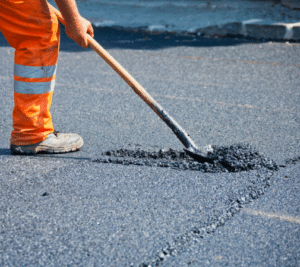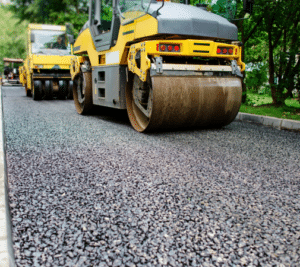There has been a growing interest in using recycled materials for construction projects in recent years. Crushed concrete, also known as recycled concrete, is one such material that has gained popularity in the United States.
Let’s explore a short history of crushed concrete, its properties, its pros and cons, and ways it can be used in residential and construction projects.
A Brief History of Crushed Concrete in the US
Starting in the 1940s, the practice of using crushed concrete in construction projects has become widespread in the United States.
The first recorded use of crushed concrete for road and driveway construction occurred in Illinois after World War II.
The expansion of US Route 66 required recycling and reusing old concrete in the new construction.
During the 1970s, there was a push to reduce landfill waste, increasing the use of crushed concrete in construction projects. As recycling efforts intensified in the 1980s, the popularity of crushed concrete continued to grow.
What Is Crushed Concrete? What Are Its Properties?
Crushed concrete is made by breaking up recycled concrete and crushing it into small pieces. The resulting material is used as a base or filler in construction projects.
It can be used in various applications, including as a base material for roads and highways, a filler for retaining walls, and a base for landscaping projects. It’s common to see crushed concrete in residential driveways.
In addition to being versatile, crushed concrete has a couple of other properties that make it a desirable material for construction projects.
For starters, it is cost-effective compared to traditional building materials, such as gravel or asphalt, making projects much more affordable.
Additionally, it can be porous, allowing water to flow through it, which can be beneficial for drainage and erosion control.
What are the Pros of Crushed Concrete?
There are several advantages to using crushed concrete for construction or residential projects:
It’s cost-effective: It is an affordable alternative to traditional building materials like gravel or asphalt. It can be an ideal choice for those on a tight budget.
It can be permeable: It can be installed to allow water to flow. This can be beneficial for drainage and erosion control.
It’s versatile: It can be used in various construction applications, including as a base material for roads and highways, as a filler for retaining walls, and as a base for landscaping projects.
It’s eco-friendly: By encouraging the reuse of old concrete, it reduces the chances for concrete to end up in refills and slows the production of new concrete.
What are the Cons of Crushed Concrete?
Despite its advantages, crushed concrete also has its drawbacks. Here are some of the cons of using crushed concrete:
Low durability: Traditional concrete is more durable than crushed concrete. Over time, it must be replaced or topped off with additional crushed concrete.
Creates dust: It can create a lot of dust during installation and use, sticking to vehicles. This can also be a problem for people with respiratory issues or allergies. To minimize dust, it is recommended to wet down the crushed concrete before installation.
Aesthetic: It may be less visually appealing than other materials depending on taste and application. Its grayish color and rougher look may not suit all landscaping projects.
Limited permeability based on how it is installed: While concrete can be porous, its permeability is limited by how it is installed. If not installed properly, it can create drainage issues and cause flooding.
Can harden and reduce height over time: It can harden and settle over time, which can cause a reduction in height. This can be problematic for structures that rely on a certain height of the concrete.
Crushed Concrete vs Gravel
Crushed concrete and gravel are both commonly used for driveways, pathways, and other outdoor applications. While it might look similar and be used in similar applications, there are some key differences to be aware of.
Crushed concrete is made from recycled concrete, making it more sustainable than gravel. It is also cost-effective and more permeable than gravel, which can help with drainage. However, it is less durable than gravel and can create dust during installation and use.
Gravel, on the other hand, is a naturally occurring material that is mined from rivers, lakes, and other sources. It is durable and long-lasting but can be more expensive than crushed concrete. It is also less permeable than crushed concrete and may require additional drainage solutions.
Ultimately, the choice between crushed concrete and gravel will depend on various factors, including cost, durability, and aesthetic preferences.
A Few Ways to Use Crushed Concrete
Crushed concrete can be used in various ways, making it versatile for outdoor projects. Here are a few ways to use crushed concrete:
Crushed Concrete Driveway: It is a popular material choice for driveways due to its affordability and permeability, as mentioned above. It is also easy to install and maintain, making it a practical option for homeowners looking to redo driveways.
Raised garden bed and landscaping: It can be used as a base material for raised garden beds, providing a stable foundation for growing plants. It can also be used as a landscaping material to create pathways or as a decorative element in outdoor design.
Retaining walls: It can be used to build retaining walls, providing a cost-effective and sustainable alternative to traditional materials like brick or stone.
Conclusion
In summary, crushed concrete is a sustainable and cost-effective material with various applications in outdoor projects.
While it has its drawbacks, such as low durability and dust creation, its benefits, including cost-effectiveness and versatility, make it a popular choice for driveway, landscaping, and retaining wall projects.
As recycling efforts continue to grow, crushed concrete will likely remain an essential material for outdoor construction and design.



